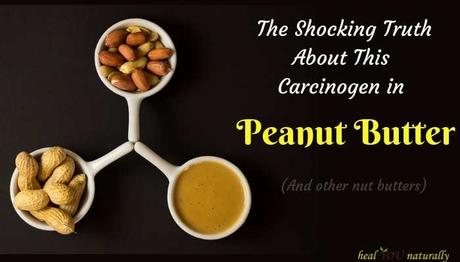
In recent decades people have become more concerned about what is in our food. Whether it is preservatives and additives or pesticides used in non-organic farming, we are becoming more conscientious about what goes into our bodies. Carcinogens in peanut butter are no exception.
Nut butter has not escaped the careful scrutiny of meticulous consumers, and peanut butter may be the worst culprit of them all. While all nut butters are susceptible to carcinogenic mycotoxins, the peanut's porous shell allows various chemicals and fungi to permeate right to the legume itself.
It all comes down to aflatoxin, what it is, and how it affects the peanut and tree nut crops that produce various nut butters.
What is Aflatoxin?
Aflatoxin is a type of mold produced by a naturally occurring fungus that grows in soil where peanuts are produced. It has also been found in crops such as corn, cottonseed, and tree nuts according to the National Cancer Institute. It is a known human carcinogen that has been linked to causes of liver cancer in developing countries.
Aflatoxins are also considered to be a potential link to increasing food allergies. In fact, there are many symptoms that correlate to aflatoxin exposure, including autoimmune disease reactions, growth and development impairment, inflammation that affects the heart, damage to digestive organs such as the liver and kidneys, and more.[1]
It is because of aflatoxin that 99% of US farmers use a fungicide on their crops. Unfortunately, because of the porous shell of peanuts, the legumes soak up the fungicide which can lead to other health problems down the line.
Peanut Butter and Aflatoxins
The reason that peanut butter is more susceptible to this carcinogen than other nut butters is that peanuts, unlike other nut butter producing nuts, are actually a legume. Unlike a hard shell of actual nuts, peanuts have a porous shell which allows mycotoxins and fungicides to enter through the shell right to the peanut itself.
Unfortunately, other nut butters are also susceptible to aflatoxin exposure as well through their roots. The good news is that there are measures you and your family can take to help avoid exposure to aflatoxin as well as fungal pesticides used to stave off the dangerous mycotoxin.
What You Can Do To Avoid Aflatoxins in Peanut Butter
Fortunately, there are steps that you can take to avoid consuming aflatoxin in peanut butter:
- Avoid foods that are known to contain aflatoxins. This is the only true way to be sure that you are not consuming this potentially dangerous mycotoxin. The most known culprit is corn but it is also found in peanuts, tree nuts, dairy from CAFO's, Genetically modified soybeans (GMO's), figs, and certain dried spices.
- Be sure you buy your peanut butter from certified organic sources that are strict with where they source, store and package their products. This assures that there will be no harmful fungicides in what you consume.
- Try alternate nut butters like almond butter, cashew, or even sunflowerseed butter. While other nut butters have been known to contain aflatoxin the worst of them by far is peanut butter.
- When buying peanut butter try to get Valenciaor jungle peanutswhich are typically grown off the ground which will eliminate the issue with aflatoxins.
- There are other good options from companies that have strict standards when it comes to testing for Aflatoxins like Maranatha. One thing that liked about this brand is that they use the Valencia variety peanuts to make their peanut butter. Here's what Maranatha has to say about their product: Every load we receive comes with an aflatoxin certificate indicating the peanuts have been tested and passed by a USDA approved laboratory. In addition to these government mandated tests, we also perform random tests on peanuts we receive and on our finished nut butters. . In summary, although aflatoxin can be a serious health concern, with USDA and FDA mandated testing and our purchasing and handling procedures, we know that our products are virtually free of it.
- Be sure to keep your nut butters in the refrigerator at all times. Keeping your peanut butter cool helps prevent mycotoxins from being able to grow and flourish in an already packed jar.
- Store your nut butters in glass jars to prevent any toxins from plastic leaking into your food as well.
- Add a high-quality chlorophyllor the derivative chlorophyllin will help reduce the number of aflatoxins in your body.
- Finally, stick to well-known brands and research any new brand you are considering trying out. Name brands are familiar with regulations in place to test for aflatoxins in nut butters. So sticking with a brand name assures that the company has taken every measure necessary to test for mycotoxins and only produce batches that are safe for human consumption. Call or read their website about the steps taken to lower aflatoxins in their nut butters.
Sources
[1] Aflatoxin: How to Avoid this Common-Food Carcinogen, Dr. Axe
[2] Intake of aflatoxins through the consumption of peanut products in Brazil.
2011;4(2):99-105. doi: 10.1080/19393210.2011.561931. Epub 2011 Apr 8.
[3] Detection of Aspergillus flavus in stored peanuts using real-time PCR
and the expression of aflatoxin genes in toxigenic and atoxigenic A. flavus isolates
Foodborne Pathog Dis: 2015 Apr;12(4):289-96. doi: 10.1089/fpd.2014.1854. Epub 2015 Jan 26.







